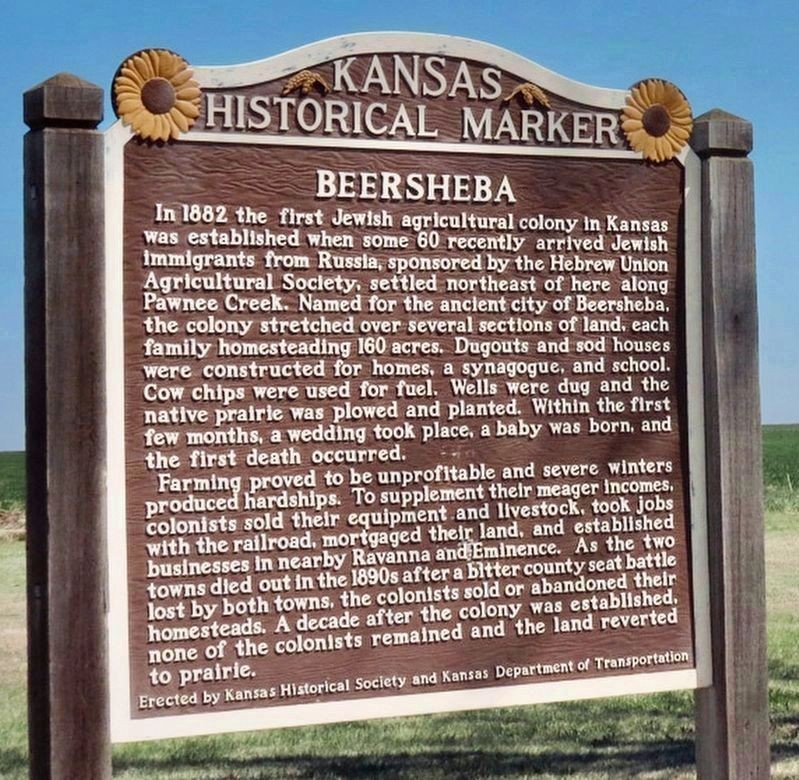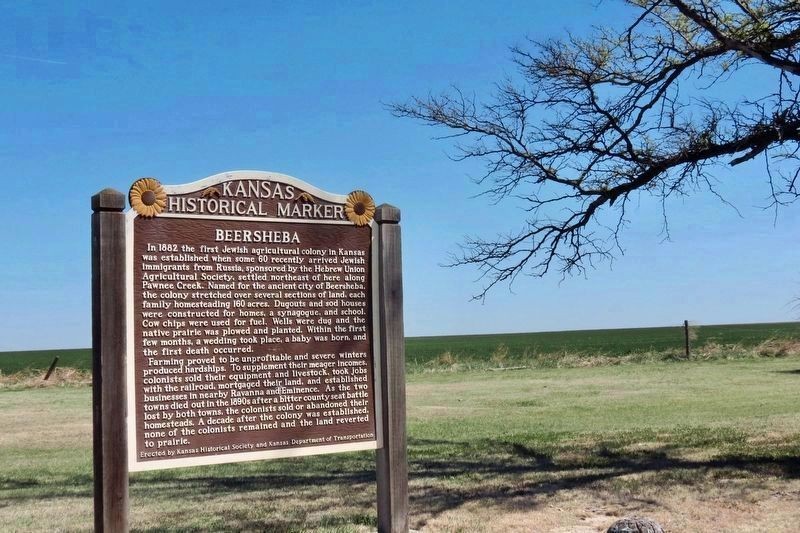Beersheba Jewish Agricultural Colony Historical Marker
Introduction
Text-to-speech Audio
This marker is located at the rest stop not far from the intersection of Kansas Route 156 and Kansas Route 23 to commemorate the nearby site of the first of seven Jewish agricultural colonies founded in the late nineteenth in the state of Kansas. Twenty-four Russian Jewish immigrant families, with the support of the Hebrew Union Agricultural Society, moved to western Kansas and settled along Pawnee Creek in 1882. The new arrivals found that the rainfall level this part of Kansas had received in recent seasons was atypical of the relatively arid land that requires irrigation, and without the resources to secure reliable quantitates of water, farming was difficult. The experiment demonstrated an experience that would be replicated by other groups of settlers who were unprepared for the prairie climate, and like those colonies, Beersheba was slowly abandoned and settlers found work in nearby towns or moved to larger cities. By 1890, none of the colonists remained although two of the later Jewish settlements were more successful.
Images
The Beersheba Marker, located at the rest stop off of the intersection of Kansas Route 156 and Kansas Route 23.

The Beersheba Marker, located at the rest stop off of the intersection of Kansas Route 156 and Kansas Route 23.

Backstory and Context
Text-to-speech Audio
1882 was the beginning of a significant wave of Jewish immigration to the United States from the Russian Empire as a result of the pogroms that swept Russia. These newcomers were often ostracized by the more-established generations of European Jews who had arrived in America in previous decades. While sympathetic, many of people of Jewish origin in the United States arrived in previous generations form central and western Europe. In addition to seeing themselves as culturally different than the new arrivals, there was concern that the arrival of many impoverished people of Jewish descent could damage the image of Jewish people in America. With the new arrivals generally speaking Yiddish arriving in large cities, the Hebrew Union Agricultural Society in Cincinnati decided to encourage the new arrivals to establish self-sustaining agricultural colonies. This led to the founding of Beersheba in in Hodgeman County. Despite limited supplies, the new arrivals built homes, a schoolhouse, and a synagogue out of sod and used cow chips for fuel.
The colony faced a number of difficulties starting with their first year. Some years later, people speculated that Beersheba had struggled thanks to a drought, but lack of rainfall doesn't may not have been the largest issue although the semi-arid prairie of western Kansas did not aid the new arrivals, many of whom had lived in cities in Russia also were adjusting to rural life. In response to some of the challenges, and in need of money, some of the men who might have been able to help the agricultural colony had little choice but to seek jobs with the railroad in Cimarron, Kansas.
With limited resources and a difficult climate for agriculture without the resources to support irrigation, the colonists abandoned Beersheba by 1890. Most of those who remained either went to Cimarron for work with the railroad or became merchants in the nearby towns of Ravanna and Eminence, two communities that were in the middle of a bitter battle for the county seat. After it was determined in 1892 that nearby Garfield County had been illegally organized, those towns were abandoned too, and the former Beersheba colonists moved to places like Dodge City, Kansas City, and Wichita. Today, while remnants of the twin towns can be seen where Garfield County once was, nothing remains of Beersheba.
Beersheba was one of seven Jewish agricultural colonies founded in the late nineteenth century and sponsored by the HUAS or other Jewish organizations. The others included Gilead in Comanche County, Hebron in Barber County, Lasker in Clark and Ford Counties, Leeser in Finney County, Montefiore in Pratt County, and Touro in Kearny County. While some of the Jewish colonies, especially Gilead and Hebron, met with more success, each of the other settlements were abandoned by the 1890s. Many of the descendants of the colonies remain in Kansas and are prominent in cities like Wichita to this day.
Sources
Kansas Heritage: Jewish Colonies in Kansas, Forsyth Library Research Guides. April 25th, 2022. Accessed September 3rd, 2022. https://fhsuguides.fhsu.edu/kansasheritage/jewishcolonies.
Kansas Historical Markers, Kansas Historical Society. Accessed September 3rd, 2022. https://www.kshs.org/p/kansas-historical-markers/14999.
Eminence and Ravanna – The Story of Finney County’s Ghost Towns, Finney County. Accessed September 3rd, 2022. https://www.visitgck.com/eminence-and-ravanna-the-story-of-finney-countys-ghost-towns/.
Goldman Feld, Lipman. New Light on the Lost Jewish Colony of Beersheba, Kansas, 1882–1886. American Jewish Historical Quarterly, vol. 60, no. 2159 - 168. Published December 1st, 1970. JSTOR.
Shpall, Leo. Jewish Agricultural Colonies in the United States. Agricultural History, vol. 24, no. 3120 - 146. Published July 1st, 1950. JSTOR.
Jewish Farming Communities, Kansas Historical Society. September 1st, 2011. Accessed September 3rd, 2022. https://www.kshs.org/kansapedia/jewish-farming-communities/12101#:~:text=Seven%20Jewish%20agricultural%20colonies%20were,and%20Touro%20(Kearny%20County)..
Hilton, Mark. Beersheba, The Historical Marker Database. November 16th, 2020. Accessed September 3rd, 2022. https://www.hmdb.org/m.asp?m=160235.
Elizabeth Winter, HMDB.com
Elizabeth Winter, HMDB.com
